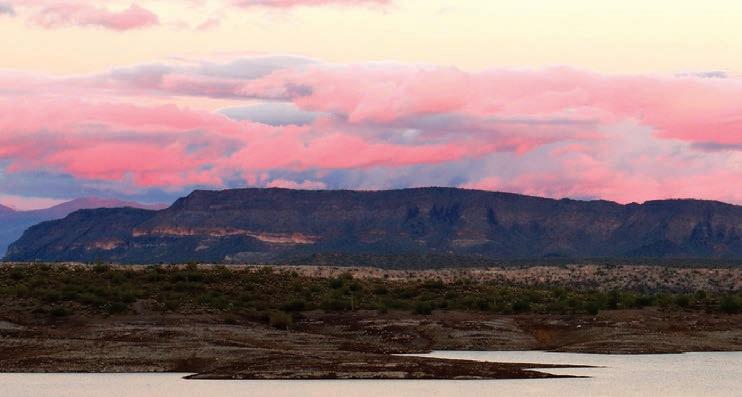
20 minute read
Turtle Bay Resort
Lynnette, a librarian, and her just-retired husband, Mario, traveled from Melbourne, Australia, to celebrate Mario’s 60th birthday in Hawaii. We met in the elevator on our first day at Turtle Bay Resort in Kuhiku and she was pleased to know there were laundry facilities on the third floor. The couple booked five nights at the Oahu resort located on the world-famous North Shore of Oahu, and they brought “the kids” along— their two young adult children, Rebecca and Michael.
This is not unusual: As I explored the grounds upon arrival, a nursing mother sat by the resort’s casual pool overlooking a favorite local surf spot and a pod of youngsters happily played in the sand at another one of Turtle Bay’s many kid-friendly areas. In fact, the resort closed its child care center for lack of interest: Everyone wants to hang out together and indulge in the multitude of activities offered.
From a gentle protected beach for swimming to horse stables and trail rides along the sea to two 18-hole championship golf courses and 12 miles of hiking and mountain biking trails, there is something for everyone. There’s Turtle Bay Resort Family fun on Oahu’s North Shore By Leslie A. Westbrook hula, surf and stand-up paddle boarding with a dog, tennis and even ukulele lessons. All ages will find plenty to do (or not do) at this super family-friendly retreat that also appeals to couples.
The property encompasses nearly 1,300 acres on the island of Oahu’s North Shore—providing plenty of room for one and all to spread out and enjoy.
Mario and his son planned to play golf together the next day (on his American time birthday); the night before the family splurged on dinner at the most upscale of the resort’s restaurants that include Pa‘akai (North Shore farm- and sea-to-table cuisine); Lei’s Lei’s at the golf course (we heard rave reviews from other guests) and Roy’s Beach House for lunch/dinner. The Lobby Lounge has pastries, fruit in the a.m.; cocktails at night with an ocean view. There’s even a nightclub with live music on site that’s popular with locals simply called Surfer, The Bar. With a lovely view of the sea, from our fifthfloor hotel room in one of the 410 ocean view guest rooms, my sweetie Phil and I planned a full day ahead of our short two-night stay: He went off to explore hiking trails and practice gi qong; I decided to check out the hula class. We agreed to meet up for ukulele lessons at 8:45 a.m. From there we were off and running! Joining our a small group for free ukulele lessons was a couple from Minnesota celebrating their 25th wedding anniversary, a young permaculture farming family from New Zealand: 9-year-old daughter, Lacey, and her mum, Lynore Oakley, engaged in the class, while dad looked after their curly redheaded youngest family member, 4-year-old River. A mom from Berkeley with Erica, the Colombian nanny to her to daughters, strummed along as well, while the two daughters were elsewhere with their other mom. Another family with adorable 7-year-old, culturesharing cousins Emily, from Long Island, and Ina, who lives in North Korea, was meeting in Hawaii for a

family vacation with the Korean grandparents. Ina was a natural and as it turns out, has a ukulele at home.
The ukulele, originally brought to the Hawaiian Islands from Portugal, our teacher Alii Pukahi told us, means “jumping” and “flea” because the immigrant Portuguese played the instrument so fast that their hands resembled jumping fleas.
In less than an hour, we all learned to strum and sing along two songs: “You Are My Sunshine” and “Twinkle, Twinkle Little Star.” Turtle Bay is also a fine place for romance. I came with my ocean-loving partner and we discovered plenty of quiet places to stroll and enjoy the mesmerizing aqua-colored waves with repeating sets of hypnotic, foamy, white waves breaking.
We enjoyed a casual lunch at The Point poolside bar with great, albeit windy, Pacific views—tasty kalua pork tacos for me, Ahi salad for him. Our friendly local bartender offered up great off-property island tips, including the huli huli chicken, shaved ice and mochi balls in the historic town of Haleiwa (we stopped at Ray’s on our way back to the airport for chicken to go).
The resort also gets a lot of repeat business, like the “Star Trek” TV producer who was visiting for the umpteenth time with his wife. He ordered something at the bar called a “Monkey’s Lunch,” a blended drink with bananas, Kahlua and Bailey’s Irish Cream that probably rings in at about a million calories. “I drank 10 in a row once,” he bragged, but then lamented, “that was a long time ago and I gained 15 pounds!”
I doubt it contained more calories than the Lava Flow my local friend, Lori, insisted I
try: a pina colada made with half and half, with strawberry syrup swirled throughout the refreshing mix that mimicked Madame Pele trapped in a cocktail.
I was excited and curious to try the latest spa specialty—the HydraFacial, administered by the delightful and engaging Maygen, a local mother of three. I showered, took a sauna and went to the outdoor rest area with ocean views to wait for Maygen and was off ered a complimentary glass of sparkling wine. “It’s happy hour,” I was told (noon to 5 p.m. weekdays). Maygen went to work on my face with a sort of mini vacuum that instead of being pinched and squeezed was a painless and effective deep cleaning treatment. I didn’t notice a huge change (Phil told me my face looked “plumper”), but I did love the treatment and would do it again in a Hawaiian heartbeat.
Our last activity was a fantastic Tahitian Fitness dance class, created by Penny Toilolo from Laie, known as the mama of Tahitian dance. Her student Siona taught our class. For an hour, we swayed and swiveled our hips, gently moved our arms and built up to a frantic, sweat-inducing pace complete with yelps! We now have plenty of reasons to join other repeat visitors—to hop atop a horse, try a surfing lesson with Rocky Canon (with a dog on board) and improve our ukulele and Tahitian dance skills.
A “hui hou”—until we meet again, Oahu! For now, we will just have to practice what we learned at home and embrace the sweet aloha spirit in our hearts and souls with memories of Oahu’s awesome North Shore.



Turtle Bay Resort 57-091 Kamehameha Highway, Kahuku, Hawaii 1-808-293-6000, turtlebayresort.com
Go Local
One nice thing about the superfriendly hotel staff at Turtle Bay is their tips on off property things to do. Here are a few:
We stopped at the farmers market at Waimea Falls on the way to the resort and enjoyed tasting and trying samples of everything from glutenfree banana bread to falafel waffl es and potions made from native plants said to alleviate pain from arthritis and other ailments. Waimea Valley Farmers Market at Waimea Falls; Th ursdays 3 to 7 p.m.; 59-864 Kamehameha Highway, Hale’iwa, Hawaii. Huli huli chicken: Only open on the weekends, Ray’s Kiawe Broiled Chicken off ers rotisserie plates to go.


Locals like Turtle Bay bartender Allen order both the “chopped and the whole, so I can nibble on the chopped on the way home,” he says. Ray’s Kiawe Broiled Chicken, 66-160 Kamehameha Highway, Hale’iwa, Hawaii (Saturday and Sundays only). Best food trucks: Tourists stop at food trucks at famous Sunset Beach, but locals know the best food trucks are in Kahuku, a bit farther down the highway. Crystal healing treatment: Local Shawna Renee off ers hour-long treatments ($60) to balance the chakras incorporating specially blended oils. A keepsake vial of moon water and crystal to “anchor one’s intentions” rounds out the experience. To book appointment: magikalenergy.as.me
By Land or By Sea




Lake Pleasant
Rec activities aplenty at Lake Pleasant and Phoenix Sonoran Preserve
With an average of 3,872 sunshine hours per year, Phoenix is one of the top 10 sunniest places in the world. For outdoor enthusiasts this means the Valley of the Sun is one of the best places on the planet to get out and enjoy nature by land or water. Lake Pleasant Regional Park By Dena Roché
Most people don’t expect a 23,000-acre water playground smack dab in the middle of the desert, but that’s exactly what awaits visitors to Lake Pleasant Regional Park. Th e manmade lake was created by construction of the Waddell Dam, which obstructs the Agua Fria River. Th e park is one of the most beautiful outdoor recreation areas in the Valley.
Lake Pleasant is a boating lover’s

dream, with two marinas off ering a plethora of water activities. Pleasant Harbor is the closest marina to Downtown Phoenix and it’s the perfect starting point for a day boating, kayaking, water skiing, wakeboarding or even fl yboarding.
A variety of boats, kayaks, paddleboards and jet skis are available to rent. Th e American Sailing Association off ers sailing lessons and clinics, while Tiller & Kites is the only international yachting school in Arizona. Kids
Lake Pleasant Cruises provides a sedated experience. (Photo courtesy Lake Pleasant Cruises)

and the young at heart will love the adrenaline rush while experiencing the world’s largest fl oating waterslide.
For a slightly more sedated experience, Lake Pleasant Cruises off ers a variety of daily cruises on the lake, and Dillon’s Bayou restaurant is an ideal place to kick back and enjoy live music or daily social activities lakeside. Travelers who want to spend multiple days at the lake can check into the marina’s fullservice RV resort, featuring a club house, pool, Jacuzzi and plenty of recreational activities including pickleball, basketball and bocce ball.
For anglers, Lake Pleasant off ers fi shing from the shoreline or by boat. Th e fi sh are biting best in spring and summer. In spring, large-mouth and white and striped bass are in season. With extreme temperatures in summer, night fi shing is a popular activity and increases the chances of reeling in a large-mouth bass. White bass and stripers are active in deeper waters, while catfi sh are active at night in the coves.
Some of the best inland scuba diving in the Western United States is found at Lake Pleasant. Reaching a depth of 260 feet and fi lled with rock walls, canyons and underwater structures, diving here provides lots of opportunities for exploration at all ability levels. Swimming is allowed, but there are no beaches and no lifeguards.
Th e calm lake waters are an ideal place to channel Zen with a paddleboard yoga class. Phoenix Sonoran Preserve
If you’re more of a landlubber don’t despair,
the Valley’s weather and terrain makes the area a hiking paradise. With more than 9,600 acres and 36 miles of trails departing from three central trail heads, the Phoenix Sonoran Preserve in North Phoenix gets you up close to explore the wild desert landscape.
The Desert Vista Trailhead, located in the southern section of the Preserve, offers everything from the flat 1-mile Bobcat Trail for novice hikers, to one of the hardest trails in the Valley, the Dixie Mountain Summit Trail. Most of the hikes from this trailhead are rated moderately difficult.
From the northern Apache Wash Trailhead, hikers have the opportunity to scale two peaks that are part of Phoenix’s Seven Summit Challenge. The relatively easy Apache Vista trail takes hikers to the summit, affording 360-degree views of the Valley, while the Ridgeback Overlook Trail is a quick loop trail that offers great southern views.
The Desert Hills Trailhead is home to the Sidewinder Trail, the most technically challenging hike in the North Sonoran Preserve. This 7-mile trek meanders up and down and connects with several other trails taking the hiker into tight washes, flats and climbs.
The Phoenix Sonoran Preserve also is a great spot for mountain bikers to test their skills. For intermediate riders, the 13-mile, nontechnical Sonoran Desert loop trail offers challenging climbs, tight turns and long flowing downhills. It’s best to run the trail clockwise, and there are great views throughout the journey. Most of the above trails can be enjoyed on two wheels instead of two feet.
Whether you want to strap on a pair of water skis or a pair of hiking boats, paddle a kayak or careen down a trail on two wheels, the sunny days in Phoenix offer a host of outdoor adventures waiting to be explored.
Phoenix Sonoran Preserve. (Photo courtesy city of Phoenix Parks and Rec)
anthem days 21 st Annual Business Expo & Festival
March 28 & 29 • 10 a.m.-4 p.m. Anthem Community Park 41703 N. Gavilan Peak Parkway
Enjoy these events all weekend: • Business Expo & craft vendors • Frazier Shows Carnival (starts Thursday) • Food Court and Rotary Beer Garden • Kids’ Zone (with inflatables; fees apply) • LIVE music
SATURDAY-ONLY EVENTS • LIVE music by Otis & The Beat - 11 a.m.-3:30 p.m. • OSR Soccer Challenge (in partnership with Phoenix Rising)
SUNDAY-ONLY EVENTS • Eggstravaganza Egg Hunt (featuring Peter Cottontail and the Hippity Hop Band) • LIVE music by Slingshot - 11 a.m.-3:30 p.m.

Enter at the ACC booth to win a Cosori Air Fryer. Submit a completed incentive card with 10 booth stamps. Must be 18 yrs. + to enter.
For illustrative purposes. Item may vary.
It is easy to be attracted to shiny things, to things that glow in the dark—even to making ourselves glow in the dark. So, in 1917, aft er the discovery of radium and its commercial uses, one couldn’t be blamed for wanting to light up the world with this radioactive element.
No one thought then that this new scientifi c breakthrough would spell the death of hundreds of women who worked in factories painting watch dials. Th ose that did suspect, worked hard to cover it up in the name of profi ts.
“Radium Girls” by D.W. Gregory tells the story of these women and how they had to fi ght the company’s owners, the law and even their own families to be heard and to protect future workers. It’s a play that Mark Clemente is directing at Starlight Community Th eater Friday, March 27, to Saturday, April 4. Fighting an unsafe workplace
Th e story reminded him of reading Upton Sinclair’s “The Jungle” when he ‘Radium Girls’ tells true tale of workplace harm By Bridgette Redman


was in high school, a book that told the story of pre-OSHA factories where conditions were unsafe and workers had no recourse to protect themselves, especially if they were poor and afraid of losing their jobs.
In “Radium Girls,” the women who worked in the watch factories contracted radiation poisoning because they were directed to “lip, dip, paint,” a process in which they would make their fi ne paint brushes into a point by licking it with their lips or tongue and then dipping it in the radium and painting the watch faces so they would glow in the dark. Th ey were paid a penny and a half per dial, with a standard rate being 250 dials a day.
“Th e women had no idea. Th ey were led to believe they were in a safe work environment,” Clemente says. “Th e script focuses on one central character: Grace Pryor.”
While there were many women who died, Pryor was one of fi ve factory workers, dubbed “the Radium Girls,” who spearheaded a lawsuit against U.S. Radium at a time when companies were considered exempt from liability for worker injuries. It took her years to fi nd a lawyer, and the eventual lawsuit created new legal precedents and regulations regarding workplace safety standards.
The play follows her through her life at work and at home from age 17 to 35.
“In this story you get to follow one woman and see what transpires in the world around her,” Clemente says. “You want her to win, even though, in the back of your mind, you know everyone is going to die. Your heart goes


out to her and you have more human empathy with her because you are following her story.” About 4,000 women worked in plants, painting watch faces with radium, and it is unknown how many died, though many suff ered from anemia, bone fractures and their bones, especially in their jaws, decaying. Th e companies asked them to meet with doctors who gave them false diagnoses and even spread gossip that the women were suffering from sexually transmitted diseases in an attempt to discredit them.
“(Grace) was just your everyday housewife,” Clemente says. “Th ey were all led to believe they were doing something for the good of the country because they couldn’t go to war and were left behind. For her, it was her plight and her pending marriage with her boyfriend and how he stuck by her and didn’t want to leave her. Your heart aches for her. “You want her to be happy, but her friends are dying, her friends are getting sick and she’s the last one. She was the one the reporters gleaned on to tell the story and she’s really the one who broke the story to the newspapers as well as going to court. She was kind of the leader for all the dial painters.”
She will be played by Harleigh Irizarry, who has appeared in several youth and community shows in the Valley, including “Once Upon a Mattress” that she did with the director nearly 10 years ago when she was 9 years old. She’s also done other shows with Starlight, including “Revenge of the Space Panda.” “She’s a good actor and I think she has the adaptability and fl exibility to play Grace at 17 and play Grace at 35,” Clemente says. “She will be able to portray the innocence of Grace as a younger woman as well as the maturity and the intestinal fortitude of Grace in her 30s.” Creating the story environment Th e “Radium Girls” script is one Clemente
has been wanting to direct since fi rst reading it. He was instantly struck with how visual it was and the things he could do with the set and lighting to help tell this very intense, historic story.
It is his fi rst time working in the Starlight space and he feels its unique setup is perfect for telling this story.
“My initial reaction was, ‘Wow, this would be fun to stage,’” Clemente says. “I’m a very visual person. Part of directing theater really is just being able to tell the story with pictures. It excites me if I can get through the fi rst fi ve pages of a script and visualize what the set would look like, what the lighting will be.” He has plans for dividing the stage into three parts, each with its own meaning and look. One side will be the corporate world; the other side will be Grace’s and everyone else’s home life as well as their doctors and hospitals. He’s juxtaposing two opposite ideas—the one that is about money and exploiting people as well as all the corruption that can happen in the corporate world and the other is the home life with people who are caring and want to help.
“I am strategically staging it in a manner where I keep those worlds very different and separate,” Clemente says. “In the middle is where the two worlds meet, such as the dial painters’ workplaces, the courtrooms, any of the news stories.” He says the set will be plain, using platforms and tall tables that divide the workplaces. He has some surprises planned for the set dressing along with some specialty lighting that creates an omnipresent symbol throughout the show. Costumes will help set the period. Understanding history’s relevance
Th e tales of history have always made good theater, not only because they are true but because the lessons learned continue to resonate through the ages. As an actor, Clemente says true stories appeal to him because of the way they allow him to really dig into his character and do the research into who a person was.
“It’s real, it’s not a Disney thing, it’s not a comic, it’s not made up,” Clemente says. “It is real-life people you can do some research into and portray on stage.”
And while this story took place more than 100 years ago, the things that happen continue to raise questions and concerns in 2020. It is a show that explores the challenges women face in the workplace and issues of equality. It is also one that deals with environmental concerns.
“I can equate it to various things that are happening on the planet today—fracking, contaminated water and global warming, all the things that we as human beings have created that can cause aft er eff ects we don’t know

about,” Clemente says.
He also compared it to the current vaping problems; how everyone was doing it without knowing what the eff ects were. He says there are a lot of things like that today—things that we don’t know what the eff ects will be 10 to 20 years from now.
“It is just like when smoking began in the ’40s,” Clemente says. “Everyone smoked. When everyone started getting lung cancer, people ignored it. It was similar to this—‘No, the radium isn’t killing you, it’s good for you, it kills cancer.’ Actually, it was killing them. It’s really relevant that we see these new things that are being created by humans that we don’t know what the danger is. We don’t know

what the danger of 50 years of cellphones are. It hasn’t been around long enough. We don’t know if it could cause brain tumors or other things. Th ere is a lot of technology we have today that could potentially harm us, and we don’t know.”
History continues to have lessons for us. Clemente hopes people will be interested in this show and to learn from it. While the play shares many details of what happened, it is Clemente’s hope that people will go home and research it more and see how much of the story is drawn directly from the facts.
Radium was considered a good thing because it could shrink cancer tumors. While upper management and scientists rarely handled the radium directly, the women in the factory thought it was good for them. Many dial painters thought it was fun to do such things as paint their dresses, use the radium as eye shadow or put it on their teeth when they went out at night so they would glow in the dark. Th ey had no idea it would kill them.
“We can have a discussion on how we can learn from our history,” Clemente says. “We need to research more and not just jump into the cool thing that glows and be fine with it.”

“Radium Girls” by D.W. Gregory Various times Friday, March 27, to Saturday, April 4 Starlight Community Theater, 1611 Whispering Wind Drive, Phoenix Starlightcommunitytheater.com










